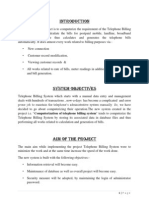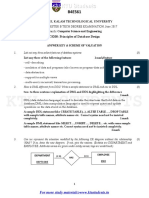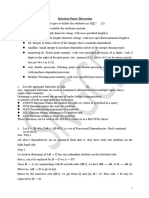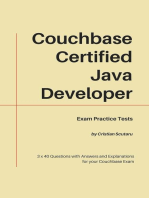0 ratings0% found this document useful (0 votes)
26 viewsS75-Subiect Examen Baze de Date
S75-Subiect Examen Baze de Date
Uploaded by
Ioana MarcThis document contains 5 questions about database concepts and relational models:
1. It asks to identify correct definitions for foreign key, relation arity, and the normalization process.
2. It asks to translate an ER diagram into relational tables and identify the relationship types.
3. It asks to write relational algebra queries on given relations schemes.
4. It asks about normal forms and decomposing a relation, and to identify correct properties of BCNF.
5. It provides relation schemas and asks SQL queries about employees, works, and departments tables.
Copyright:
© All Rights Reserved
Available Formats
Download as PDF, TXT or read online from Scribd
S75-Subiect Examen Baze de Date
S75-Subiect Examen Baze de Date
Uploaded by
Ioana Marc0 ratings0% found this document useful (0 votes)
26 views2 pagesThis document contains 5 questions about database concepts and relational models:
1. It asks to identify correct definitions for foreign key, relation arity, and the normalization process.
2. It asks to translate an ER diagram into relational tables and identify the relationship types.
3. It asks to write relational algebra queries on given relations schemes.
4. It asks about normal forms and decomposing a relation, and to identify correct properties of BCNF.
5. It provides relation schemas and asks SQL queries about employees, works, and departments tables.
Original Title
S75-Subiect examen Baze De Date
Copyright
© © All Rights Reserved
Available Formats
PDF, TXT or read online from Scribd
Share this document
Did you find this document useful?
Is this content inappropriate?
This document contains 5 questions about database concepts and relational models:
1. It asks to identify correct definitions for foreign key, relation arity, and the normalization process.
2. It asks to translate an ER diagram into relational tables and identify the relationship types.
3. It asks to write relational algebra queries on given relations schemes.
4. It asks about normal forms and decomposing a relation, and to identify correct properties of BCNF.
5. It provides relation schemas and asks SQL queries about employees, works, and departments tables.
Copyright:
© All Rights Reserved
Available Formats
Download as PDF, TXT or read online from Scribd
Download as pdf or txt
0 ratings0% found this document useful (0 votes)
26 views2 pagesS75-Subiect Examen Baze de Date
S75-Subiect Examen Baze de Date
Uploaded by
Ioana MarcThis document contains 5 questions about database concepts and relational models:
1. It asks to identify correct definitions for foreign key, relation arity, and the normalization process.
2. It asks to translate an ER diagram into relational tables and identify the relationship types.
3. It asks to write relational algebra queries on given relations schemes.
4. It asks about normal forms and decomposing a relation, and to identify correct properties of BCNF.
5. It provides relation schemas and asks SQL queries about employees, works, and departments tables.
Copyright:
© All Rights Reserved
Available Formats
Download as PDF, TXT or read online from Scribd
Download as pdf or txt
You are on page 1of 2
Subject no.
75
1. Indicate the correct answers:
1.) A foreign key is: (a.) an alternative to a unique identifier; (b.) a field that helps connecting
two tables; (c.) a clustered index; (d.) a candidate key; (e.) a field that uniquely identifies the
records of a table;
2.) The arity of a relation refers to: (a.) the number of clusteres indexes per table; (b.) the total
number of records; (c.) the total number of fields; (d.) the number of fields which form the
foreign key; (e.) the number of tables to which the current table is connected.
3.) The normalization process implies: (a.) the creation of some new tables within the database;
(b.) the alteration of the referential integrity rules; (c.) altering the database consistency over
time; (d.) the elimination of the redundancies and anomalies; (e.)the decrease of the width for
each table;
2. Translate the following E-R diagram into relational model, by indicating the schemes of
the resulting tables (table names and field names between round parentheses) and the
type of the relations between the resulting tables (e.g. Student-Groups 1-n; Student-
Teachers m-n):
Type
Name Since P_id Name
E_id Date_of_Birth End_Date
Employees Work Projects
3. Given the relation schemes:
Students (Stud_Id, Name, Surname, Date_of_birth)
Disciplines (Disc_Id, Name, Type)
Marks(Stud_Id, Disc_Id, Mark, Date_of_exam)
Solve the following queries in Relational Algebra:
a. Name and surname of the students who promoted the Databases exam, but didn’t
promote the Computer Programming exams.
b. Name, surname of the teachers who teach Mathematics.
c. Name and surname of the students that don't belong to the group 30222.
4. 1.) Indicate the correct answers:
If a relation is in the Boyce-Codd-Normal-Form (BCNF), then: (a.) every field is a
key; (b.) there exist partial dependencies between the non-key attributes and part of the
primary key; (c.) every determinant is a key; (d.) there are only atomic attributes in the
table; (e.) for every functional dependency X->A from R, where A is an attribute that
doesn’t belong to X, then X is a key, or includes a key from R.
2.) Consider the relation schema R(A, B, C, D, E) with functional dependencies AB → C,
C → D, C → E, D → A, E → B. State the normal form for R and describe functional
dependencies that violate higher NF. Decompose R into two (or more) relations who are
in highest possible normal form (if such thing is possible) and give for each relation of
your decomposition a minimal basis for the functional dependencies that hold in these
relations (eventually upload the file with the solution to Assignments).
5. Consider the following relation schemes:
Employees(e_id: integer, PK, name: string, age: integer, income: real)
Work(e_id: integer FK, d_id: integer FK)
Dept(d_id: integer PK, name_d: string, buget: real, manager_id: integer FK)
The primary keys (PK) and foreign keys (FK) are indicated above.
Solve the following queries in SQL:
a. Names of the employees who don’t work in any department.
b. Name of the departments and the number of employees for each department. For the
departments with no employees, the 0 value should appear.
c. Name of the department(s) having hired employees whose names begin with the ‘A’
letter.
d. Name of the employees who work in the Software department.
You might also like
- Database Technology Set 3Document13 pagesDatabase Technology Set 3TheOutsid3runNo ratings yet
- (Always Learning) Kahate, Atul - Introduction To Database Management Systems, 1e-Pearson Education (Singapore) (2004)Document535 pages(Always Learning) Kahate, Atul - Introduction To Database Management Systems, 1e-Pearson Education (Singapore) (2004)Dr Satish KumarNo ratings yet
- Telephone Billing SystemDocument43 pagesTelephone Billing Systemsouravroyonline78% (36)
- Questions and Answers On The Relational ModelDocument60 pagesQuestions and Answers On The Relational ModelAhmad Tariq Khiam100% (1)
- Dbms Solved PaperDocument18 pagesDbms Solved Paperyogesh gunawat0% (1)
- Hotel Database Management System SQL FinalDocument5 pagesHotel Database Management System SQL FinalAdityavardhan Tiwari100% (1)
- S74-Subiect Examen Baze de DateDocument2 pagesS74-Subiect Examen Baze de DateIoana MarcNo ratings yet
- S73-Subiect Examen Baze de DateDocument2 pagesS73-Subiect Examen Baze de DateIoana MarcNo ratings yet
- Subiect Examen Baze de DateDocument2 pagesSubiect Examen Baze de DateIoana MarcNo ratings yet
- Part - ADocument3 pagesPart - Ashahidmohamed2004No ratings yet
- 2020 Solved DBMSDocument15 pages2020 Solved DBMSBen JohnsonNo ratings yet
- S76-Subiect Examen Baze de DateDocument2 pagesS76-Subiect Examen Baze de DateIoana MarcNo ratings yet
- Reg No.: - Name: - NameDocument4 pagesReg No.: - Name: - NameJobin LNo ratings yet
- Assignment DBDA PreetiDocument12 pagesAssignment DBDA PreetimounikaNo ratings yet
- dbmstotal assignment (1)Document4 pagesdbmstotal assignment (1)princesahuNo ratings yet
- DBMS QuestionsDocument10 pagesDBMS QuestionsMazharulislamNo ratings yet
- 4CSPL2011 - Web - Development - Using - Python - Django Question BankDocument9 pages4CSPL2011 - Web - Development - Using - Python - Django Question Bankanilvs2004No ratings yet
- Dbms It GateDocument35 pagesDbms It GateMurali Mohan ReddyNo ratings yet
- DBMS QuestionDocument2 pagesDBMS QuestionGolam DaiyanNo ratings yet
- Final F02Document4 pagesFinal F02Farah KhanNo ratings yet
- Gujarat Technological UniversityDocument5 pagesGujarat Technological Universitycompiler&automataNo ratings yet
- Assignment 2018-19 DBMSDocument9 pagesAssignment 2018-19 DBMSsantaNo ratings yet
- DATABASES GROUP ASSIGNMENTS April 2023Document3 pagesDATABASES GROUP ASSIGNMENTS April 2023Evans chaukeNo ratings yet
- DBMS Unit-2 PDFDocument20 pagesDBMS Unit-2 PDFKrupal SaiNo ratings yet
- dbms-2017-18Document2 pagesdbms-2017-18deepshi8686No ratings yet
- IDB PYQ QuestionPaperDocument3 pagesIDB PYQ QuestionPapervipulkumar3938No ratings yet
- Assignment 11 - SolutionsDocument3 pagesAssignment 11 - SolutionsmirroalexNo ratings yet
- Questions of DbmsDocument9 pagesQuestions of DbmsUr MnNo ratings yet
- CST 204 Database Management Systems, June 2023Document4 pagesCST 204 Database Management Systems, June 2023binnytmzNo ratings yet
- DBMS 2016Document5 pagesDBMS 2016KUSHAL SARASWATNo ratings yet
- PCCCS403Document3 pagesPCCCS403Sudip PandaNo ratings yet
- DBMCQDocument36 pagesDBMCQCrazycratersNo ratings yet
- DBMS QBDocument5 pagesDBMS QBNEELAM RAWATNo ratings yet
- Test PDFDocument2 pagesTest PDFDhananjay SinghNo ratings yet
- CS222 1Document2 pagesCS222 1Riyaz ShaikNo ratings yet
- 2018 Data Base MidDocument9 pages2018 Data Base MidAli JrNo ratings yet
- MCQDocument7 pagesMCQshamsNo ratings yet
- DBMS Complete Unit - 2Document20 pagesDBMS Complete Unit - 2dusanikhil3No ratings yet
- DBMS AssignmentDocument5 pagesDBMS AssignmentzeelsoniNo ratings yet
- Module 3 ND 4 QP DiscussionDocument13 pagesModule 3 ND 4 QP Discussionaparna21112003No ratings yet
- 3 Hours / 70 Marks: Seat NoDocument94 pages3 Hours / 70 Marks: Seat Noyashbirari29No ratings yet
- 21CS53 Assignment2Document3 pages21CS53 Assignment2Dhanush DhanuNo ratings yet
- Question Paper Mca 2 Sem Database Management Systems Kca204 2022.pdfmca 2 Sem Database Management Systems Kca204 2022Document3 pagesQuestion Paper Mca 2 Sem Database Management Systems Kca204 2022.pdfmca 2 Sem Database Management Systems Kca204 2022abhi5059272No ratings yet
- DBMSDocument18 pagesDBMSJavvaji VenkatNo ratings yet
- Unit 2Document159 pagesUnit 2karanthegreat6162No ratings yet
- MidtermPracticeQuestions SolutionsDocument6 pagesMidtermPracticeQuestions SolutionsANIL EREN GÖÇERNo ratings yet
- DBMS Question BankDocument17 pagesDBMS Question BanksanketsamantsingharNo ratings yet
- Database Systems 2Document2 pagesDatabase Systems 2Muhammad AamirNo ratings yet
- A Relational Database Consists of A Collection of A) Tables B) Fields C) Records D) Keys Ans:ADocument25 pagesA Relational Database Consists of A Collection of A) Tables B) Fields C) Records D) Keys Ans:AUTKARSH SHARMANo ratings yet
- Chapter 2Document57 pagesChapter 2Lementha YenNo ratings yet
- GATE Ques Set 1Document10 pagesGATE Ques Set 1rahulyadavsingaporeNo ratings yet
- Csi ZG518 Ec-2Document6 pagesCsi ZG518 Ec-2swetha penmetsaNo ratings yet
- Questions - DBMSDocument13 pagesQuestions - DBMSKrishna RathiNo ratings yet
- Sample Question Paper Principles of DatabaseDocument4 pagesSample Question Paper Principles of Databaselovelife96369No ratings yet
- Class 12 - Computer Science (083)Document8 pagesClass 12 - Computer Science (083)karthickeyan12345678910No ratings yet
- m2 and m3 Ans Dbms Imp 2iaDocument9 pagesm2 and m3 Ans Dbms Imp 2iaMahesh A.VNo ratings yet
- Assigment of Data Structure and Algorithm For BE SE Third Sem 1Document11 pagesAssigment of Data Structure and Algorithm For BE SE Third Sem 1Dinesh BaniyaNo ratings yet
- 1 Cs208 Principles of Database Design - Model QPDocument3 pages1 Cs208 Principles of Database Design - Model QPAtherinNo ratings yet
- GE3DBMS_TestDocument2 pagesGE3DBMS_Testmohit1022005No ratings yet
- DBMS Question BankDocument10 pagesDBMS Question BankFS20CO055 M S SarangNo ratings yet
- AP Computer Science Principles: Student-Crafted Practice Tests For ExcellenceFrom EverandAP Computer Science Principles: Student-Crafted Practice Tests For ExcellenceNo ratings yet
- Database Management System (DBMS)Document4 pagesDatabase Management System (DBMS)Yogesh KumarNo ratings yet
- Normalization Data AnomaliesDocument15 pagesNormalization Data Anomaliesgopi9966957145No ratings yet
- Dissertation NormalisationDocument9 pagesDissertation NormalisationPaperHelpSingapore100% (1)
- Session 06Document51 pagesSession 06Michael RahmeNo ratings yet
- Database Normalization Explain 1NF 2NF 3NF BCNF With Examples PDFDocument9 pagesDatabase Normalization Explain 1NF 2NF 3NF BCNF With Examples PDFRaj ShahNo ratings yet
- Chapter 6 Designing DatabasesDocument36 pagesChapter 6 Designing DatabasesCDT Feliciano Fernando JardelezaNo ratings yet
- SQL Interview Questions 1685537248Document25 pagesSQL Interview Questions 1685537248Aayushi JainNo ratings yet
- PG Syllabus 2022-24Document134 pagesPG Syllabus 2022-24sweetsantosh3535No ratings yet
- Entity and Attribute Shape: First Normal FormDocument1 pageEntity and Attribute Shape: First Normal FormsrinavNo ratings yet
- Unit - IiDocument45 pagesUnit - IiJit AggNo ratings yet
- CDB21DW018 Day1Document29 pagesCDB21DW018 Day1Karthick selvamNo ratings yet
- EE - DBMS - Unit 1 With NormalizationDocument99 pagesEE - DBMS - Unit 1 With Normalizationharsh singhNo ratings yet
- Gi Ki Course OutlinesDocument115 pagesGi Ki Course OutlinesHamzaNo ratings yet
- Dbms Report2-2Document30 pagesDbms Report2-2Rekha HNo ratings yet
- Intra Mailing System Documentation A ASP Net Project KrishnaDocument50 pagesIntra Mailing System Documentation A ASP Net Project Krishnashobhit80% (5)
- DBMS MaterialDocument70 pagesDBMS MaterialMitesh PujaraNo ratings yet
- DDD Assignment Mark Scheme Autumn 2018Document13 pagesDDD Assignment Mark Scheme Autumn 2018Nixon MaharzanNo ratings yet
- CS Model Exit Exam-1Document15 pagesCS Model Exit Exam-1Wolde JanfaNo ratings yet
- Case Study On: Clinic Management SystemDocument10 pagesCase Study On: Clinic Management SystemSabin KhadkaNo ratings yet
- Chapter 5: Database Design 1: Normalization True / False: Cengage Learning Testing, Powered by CogneroDocument6 pagesChapter 5: Database Design 1: Normalization True / False: Cengage Learning Testing, Powered by CogneroGirlie Sison100% (1)
- SAD ProjectDocument46 pagesSAD Projectsamidabala2No ratings yet
- DBA Assignment by Arslan Ahmad (1044)Document9 pagesDBA Assignment by Arslan Ahmad (1044)AzeemChaudhary100% (1)
- SQL Server and ASP Net Questions & AnswersDocument12 pagesSQL Server and ASP Net Questions & Answersashishgaur84No ratings yet
- 2018490212-Restaurant Website-ReportDocument46 pages2018490212-Restaurant Website-Reportshami CheemaNo ratings yet
- Allama Iqbal Open University, Islamabad: (Department of Computer Science)Document2 pagesAllama Iqbal Open University, Islamabad: (Department of Computer Science)Asad ShafiqNo ratings yet
- NormalizationDocument10 pagesNormalizationkakanivamsikrishnaNo ratings yet
- Learning Goals: Data Warehousing (CS614)Document8 pagesLearning Goals: Data Warehousing (CS614)Jawwad RafiqNo ratings yet

























































































